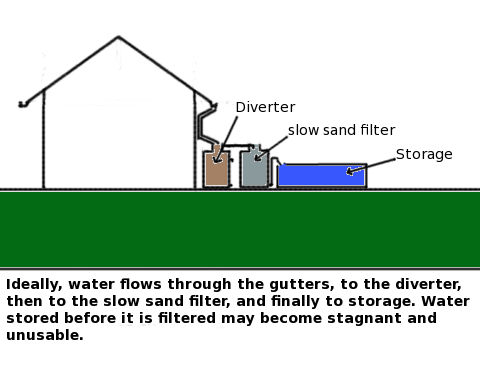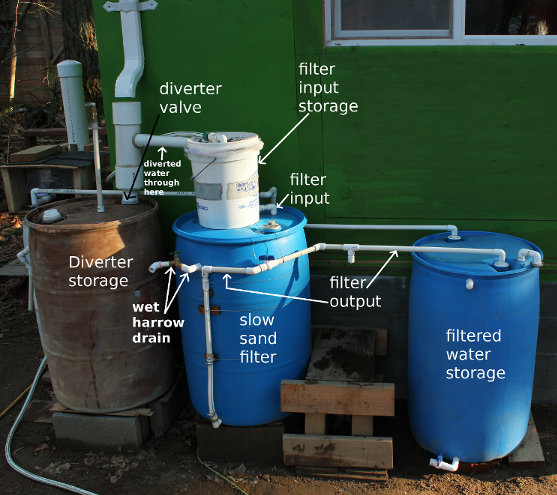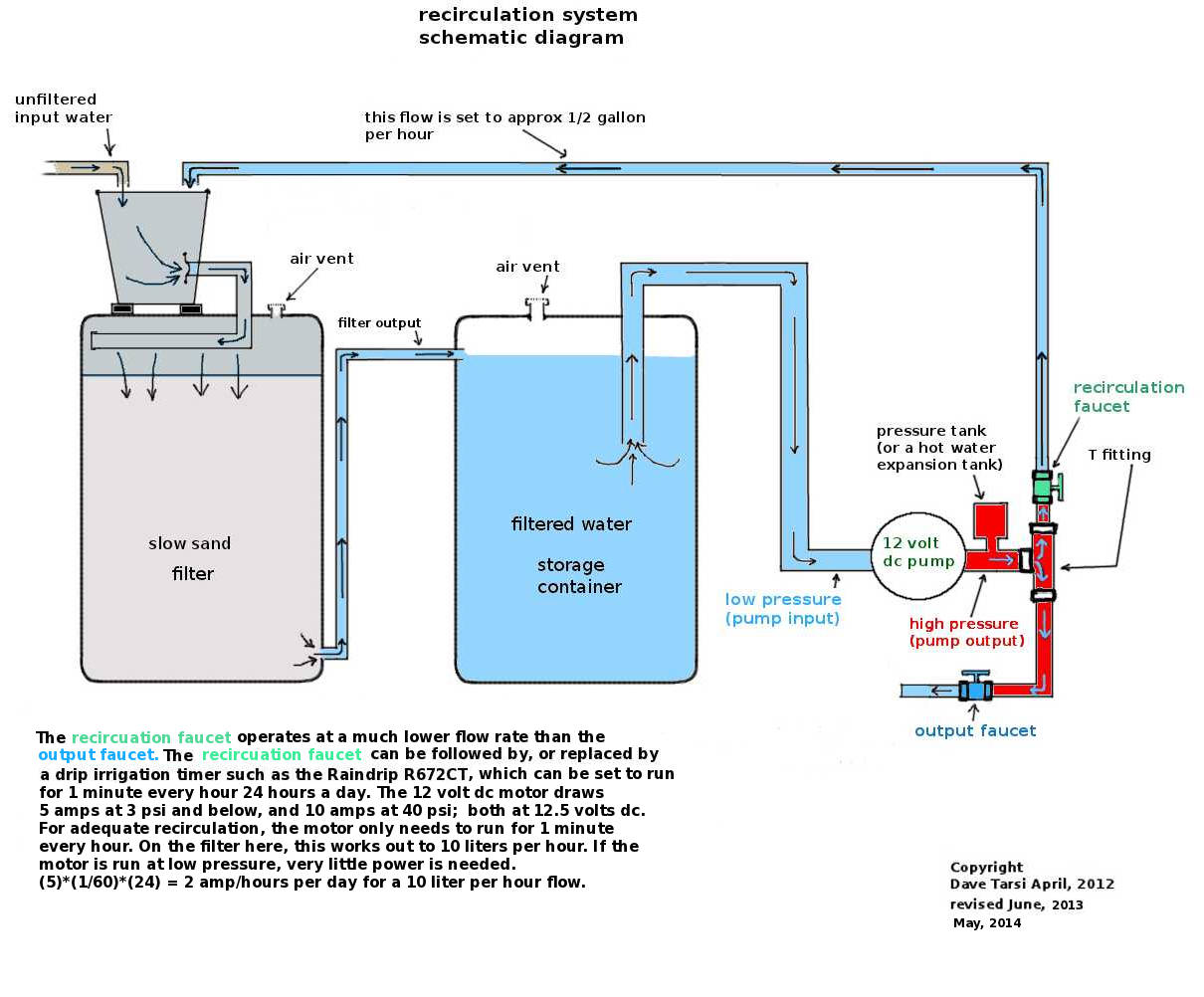
Home
> System overview
What to test for
Filter pictures
Water clarity
First flush diverter
2500 gallon cistern
About this website
Water Test Results
Conditions of Use
PDF version
Page updated:
2015-03-30
External links
Slow sand filter FAQ
Putting togther a rain water harvesting system
|
Please help support this site by purchasing, for $7.50, a summary of the most important results of our research for the past 8 years, including detailed drawings of the filters. This page on our blog has the purchase area. Thank you!! |
System design will vary but generally there will be a first flush diverter, a filter, and a storage container. The storage should be as large as possible. It can be a tank underground, above ground or partially buried. Water storage containers are referred to as cisterns. They are often built underground or partially underground.

Filter 4 was started on Nov. 13, 2011; modified on Nov 22, 2011, then restarted on Nov 22, 2011; modified again on December 14, 2011 and restarted at that time.
As of March 30, 2015 this filter is still functional.
The system shown below that works with Filter 4 (the middle blue barrel with the white bucket on top) has been in operation for 5 months as of May 14, 2012. As of May 29, 2012; the filter is consistently producing exceptionally clean water. Detailed illustrations of this slow sand filter construction are available here. A short video illustrating the operation of the system is avaialble here , and a more detailed video showing the construction of the filter is availble here. Samples of water were sent to the EPA certified testing lab on 2012-02-06 (Feb 6, 2012). The results are noted below the picture's parts description list.

PARTS DESCRIPTION LIST:
- Diverter storage:
- stores discarded diverted rainwater runoff from the roof (it will be filtered after it settles)
- diverter valve:
- the part of the diverter that controls the direction of the flow of water
- filter input storage:
- This container hooks up to the baffle inside. It allows 5 gallons of water to be added at a time for filtration and also provides a container to hold rainwater from the diverter output, so less water is lost due to overflow
- wet harrow drain:
- This is a drain that is opened to allow cloudy water to drain off when the filter needs to be "cleaned". Wet harrowing means gently agitating the water just above the surface of the sand to loosen excessive settled debris on the surface of the sand resulting from hightly turbid (cloudy) water input.
- filter output:
- This pipe is positioned on the filter at approximately 1 inch above the surface of the sand inside the container; where water is at least 5 inches above the output pipe inside the barrel (six inches above the surface of the sand). Water pressure from gravity causes flow down through the sand to the bottom of the barrel and then back up through the output pipe until the water level inside the filter is even with the output opening of the output pipe. Then the flow will stop, but there will still be 1 inch of water covering the sand surface. This happens because water seeks its own level.
- filter input:
- This is a pipe that runs from the filter input storage 5 gallon bucket to the baffle inside the filter.
- filtered water storage:
- This container stores filtered water. The one shown is a 55 gallon barrel, a larger storage container would be a much better option.
- slow sand filter:
- This is the actual slow sand water filter. See the links above this image for more details including a video of how to build this filter.
A slow sand water filter (essentially the same thing as a biological sand filter) works like this:
Water is added and flows through a container filled with sand and gravel. The sand is about 3 feet deep with 4 inches of gravel below the sand covering drain pipes. Water slowly flows through the sand and gravel to the drain pipes and then is allowed to flow into a storage container. The water must flow very slowly through the filter. A slow sand filter in a 55 gallon barrel will typically supply about 10 gallons per hour. The top surface of the sand must always be covered by at least 1/2 inch of water. After about 3 weeks, as the water flows through the sand and gravel, a layer of living microscopic organisms forms in the top few inches of the sand. This happens because almost all water (except distilled water) contains at least some aerobic bacteria, plankton and algae that stay alive by consuming bad bacteria, and protozoa in the water. This layer is not visible until it becomes very thick. Because of tiny electrical charges (called van der Waals force), on particles and bacteria in the sand and water, and because of the layer of organisms and organic material on the top few centimeters of sand; bacteria and harmful organisms are trapped and consumed as water flows down through the sand. As gravity causes the water flowing down to compact the sand; the filter's ability to remove bad bacteria and small particles below the first few inches of sand is increased because the effective distance between the grains of sand, or porosity, decreases and some additional "good" organisms grow. The water that flows out of the filter is 99.99 percent free of bacteria; in other words, the output water is purified; not just sterilzed. The water must flow slowly enough for the good bacteria to consume the bad bacteria, so some kind of flow regulation is necessary. Most small slow sand filters have an output pipe running up to just above the surface of the sand. This design functions as a regulator and causes the water to flow slowly enough to allow the bacteria to work. A slow sand filter will also remove some chemical contaminants from water, and as the filter matures it becomes more effective at removing contaminants. The sand does not need to be replaced or removed and no chemicals are needed for the filter to remove bad bacteria. The filter is cleaned by gently agitating the water over the surface of the sand just enough to produce cloudy water. The cloudy water is then drained off. This is called "wet harrowing". This is all that needs to be done. Do not backwash a slow sand filter, you will ruin it!!! - all the natural biological layers will be destroyed and the filter will become ineffective. Backwashing is for rapid sand filters and they are very different.
TEST RESULTS February 8, 2012:
I spoke with the testing lab this afternoon. The test results are here. The filter is working:
Post-filter: no detectable coliform (this also means there is no e coli or fecal coliform present in the filter output water )
Pre-filter: 1200 cfu per 100 ml each of the 1200 units represents a visible living colony formed from 1 coliform microbe.
Storage: 3 coliform cfu per 100 ml, but no e coli
Specifically, this means that water directly out of the filter has no detectable coliform bacteria in it, and water from storage is slightly contaminated with 3 coliform per 100ml but contains no e coli. IMPORTANT: This does show that contamination can come from anywhere. I had meticulously and extra carefully cleaned out the storage container with disinfectant and made sure the container was closed tightly. Still, from somewhere some coliform has managed to get into the system after the filter output. This is why it is imperitive that it be understood the water from this filter is NOT intended to be potable without careful monitoring by knowlegeable persons; and that the operation of a DIY filter is totally the responsibility of the owner/operator. No matter how careful a person is, contamination can come from anywhere. A uv filter is an absolute necessity. However, inside the filter at the output and inside the output pipe there is only purified water. But there is more. . . .
While I cannot recommend this filter as a day to day unmonitored source of drinking water, one must think aobut this: In an emergency situation (think earthquake, flooding, massive power outages, mad scrambles for bottled water at the grocery store) when there is NO water available from your usual source - this means no water - nada, zilch, ok? What will you do? Drink from a mud puddle? Think about it - Hmmmm. . . . .
It is important to note that the water which has been going into the filter on an ongoing basis has a high coliform count, and for four days before the tests went in, this highly contaminated stagnant water from the diverter storage was running through the filter (and still is). For a complete change of water to flow through the filter 33 gallons (about 125 litres) need to move through the filter. The sand holds 50 percent water by volume plus 10 gallons on top of the sand. (.5 X 45 gallons = 22.5 plus 10 gallons of water on top of the sand makes 33 gallons or about 125 litres). Over 40 gallons were added during the 4 day period prior to the tests, so we can be certain that the ouput water which was hightly contaminated when it entered the filter was purified when finished at the output.
This system has a recirculation pump, which is not absolutely necessary. The recirculation can be done manually each day, or ideally, unfiltered input water can be added once a day. Notice that each part of the system is downhill from the preceeding part - the diverter is downhill from the roof, the filter is downhill from the diverter, and the storage is downhill from the filter. This system can function with only gravity as the method of moving water through to storage, and would operate where there is no access to electricty, or petrol powered devices. The recirculation pump is a convenience that can easily be powered by an off-the-grid renewable power source.

It is important to know that water containing oxygen and organic material must be flowing through the filter in order to keep the microbes in the biofilm (schmutzdecke) alive. At this location, summer months bring little or no rain, so recirculation of filtered water is the only way to keep the biofilm alive in the filter. We take some water (2 or 3 litres a day) from the filtered water storage, and run it through the filter again Four years of tests and operation on the system with Filter 1, which is similar in design to the filter system shown above, have shown that this method of recirculating filtered water does indeed work. As with Filter 1's system, enough water is retained in the diverter storgage barrel to allow small amounts of it to be added weekly to the filter (add 100 ml of unfiltered to each 2 or 3 litres of filtered) input along with the filtered water. This supplys the nutrients that keep the biofilm alive during the dry season. note
During extended warm dry periods, the water in the diverter storage barrel may become stagnant. Do not put chlorine, ozone, or any chemical disinfectant in that water. If any disinfectant gets into the filter it will destroy the benefical microbes in the schmutzdecke and ruin the filter. As you recirculate filtered water, pour some of the filtered water into the diverter as you remove some to run through the filter; this will mix purified water with the unfiltered water in the barrel and reduce the contamination. Do not put contaminated water in the filtered water storage and use separate containers for recirculation and pure water, however - this is a no brainer but I am mentioning it anyway - don't mix the containers up. Fifty gallons will easily last the entire summer, and by the time the end of the summer arrives, the water in the diverter storage will be nearly clean.Do not use chlorine or ozone or any kind of disinfectant in your system water that will be run through the slow sand filter!!! - it will kill most of the good bacteria, protozoa, and zooplankton that make a slow sand filter work, and ruin the filter's effectiveness. To increase the overall safety of the system Post-filter water (water that flows out of the slow sand filter and will not flow back in) may need disinfectant; but this is not the only solution. A UV filter is another way to eliminate the danger from any bacteria that may enter the filtered supply. Also, Do not backwash your slow sand filter - ever. you will ruin it. Cleaning is done by wet harrowing.
The best practice is to have enough throughput from the slow sand filter to adequately handle the flow from the diverter. This may require 3 or 4 filters hooked up in parallel. Water does not flow fast through a biological sand filter; flow rates will vary depending on conditions. Sand size and length of run time are two variables that will significantly influence flow rate. Typically 35 to 55 litres per hour will flow from a filter constructed in a 20 inch diamter 4 foot deep barrel, when the filter bed is "mature". This is much slower than water from a downspout in a moderate rain event. Five or six filters or one large one would be a good idea if your entire water supply depends on the system.
note
These numbers are only valid for this filter and this situation. The amount of recirculation will need to be determined for any other filter by appropriate testing based on that filter's operating environment. The operation of any diy filter is totally the responsibilty of the owner/operator. The amounts mentioned here may not work in another situation. You have been advised.